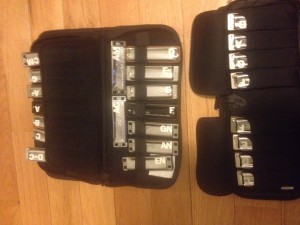
Labeling my harps for easy recognition in low light
I’m getting ready to play the Forbes/Inc. Magazine corporate battle of the bands semifinals at Gypsy Sally’s in Washington, DC on Saturday, May 30 with a band called Gartner in the Cloud. It’s going to be fun. Our set includes five tunes, all classic rock. The low tune count notwithstanding, I use five standard-tuned harps in this set: A, C, D, F, and Bb. On one tune, the Buffalo Springfield’s “Mister Soul,” I switch from 3rd position on a D harp (E minor) to second position on a Bb harp (F). It’s a short but busy gig, and one of the things I realized at the last rehearsal is that I really need to be able to find the right harp for a song without my glasses on, in a poorly lit room.
One way to do that is to stick big labels on them. After a little research, I bought a set of white vinyl 1/2″ permanently adhesive labels. They arrived today, and I spent about an hour sticking them on my harps. The results look pretty good; see for yourself.

I put all the labels in the upper right corner of the top cover plate of every harp. In order to minimize the size of text strings, I used codes for various tunings. Each label consists of the key of the instrument followed by a tuning code; if appropriate, I add “h” or “L” before the key to indicate a high- or low-pitched harp.
The tuning codes are as follows:
So a G Dorian harp would be labeled GD; a high G country-tuned harp would be labeled HGC. The main advantage of the system is that it’s compact and easily readable in all sorts of light conditions. It’s also inexpensive.
There’s one little quirk in my system. I label flat keys–Bb, Ab, etc.–with a minus sign instead of a lowercase b. The minus sign takes up less space, and the label set I bought didn’t have a lowercase b…
Practical tools like this help a lot in performance. Moving smoothly without fumbling is one of the signs of a professional; fumbling with instrument or setup changes is a sign of a novice. So go on and get your gear set up for smooth moves onstage.
Related Posts
Leave a Reply
You must be logged in to post a comment.
WHAT’S NEW
Categories
- Audio/Video
- Blog
- Blue Future
- Digitech RP Tricks and Tips
- Discography, CDs, Projects, Info, Notes
- Featured Video
- For the Beginner
- Gallery
- Hunter's Effects
- Hunter's Music
- Huntersounds for Fender Mustang
- Meet the Pros
- More Video
- MPH: Maw/Preston/Hunter
- My Three Big Contributions
- Player's Resources
- Pro Tips & Techniques
- Recommended Artists & Recordings
- Recommended Gear
- Recorded Performances
- Reviews, Interviews, Testimonials
- The Lucky One
- Uncategorized
- Upcoming Performances
- Zoom G3 Tips and Tricks